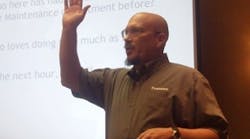The Butterfly Effect is a term that was coined by Edward Lorenz about his attempt to build a complex weather prediction model. “At times, the maintenance budget can feel this way,” said Pepsico’s Robert S. Hill II, who spoke at UE Systems’ Reliable Asset World in Clearwater Beach, Florida. “An unexpected expense in February causes enormous impact on planned expenses in November, and that causes a ripple effect throughout the year. There’s not some butterfly in your plant waiting to mess things up. The problem is we don’t have budgets that work.”
Budgets don’t reflect reality, said Hill. “Budgeting is an exercise in being wrong,” he explained. “Trying to determine what you will spend each month will always be wrong, and this is discouraging. The budget also doesn’t connect from month to month. Expenses aren’t static. Unexpected things come up. Overspending and underspending need to be carried forward. If you had materials that were purchased and delivery is delayed, you should be able to move these expenses from month to month.”
According to Hill, there are two types of budgeting: incremental budgets and zero-based budgets.
Incremental budgeting, or historical budgeting, takes last year’s budget, adds inflation, subtracts target reduction, and then averages it out over 12 months. “This has disadvantages,” he said. “It perpetuates the problems from last year. It accounts for what was done instead of what should have been done. And there’s no variation from month to month. Our budgets shouldn’t be built on a flat 12 months.”
Hill advocated zero-based budget, which is presented as Income - Expense = 0, because of its advantages in month-by-month granularity and in creating a realistic picture that accounts for real needs. “What is it I really need to maintain my plant or run projects?” he asked. “It’s based on need and benefit, and it will drive budget ownership. Zero-based can identify waste in the budget. And it aids identification of alternatives.”
The first step is to assemble the stakeholders — maintenance supervisors, maintenance planners, stockroom personnel, and operations partners. “If we don’t take their work into account, our budget will be too low to support them,” Hill stated. “Include anyone who will impact or will be impacted by the maintenance budget. We need to understand what they’re bringing to the table so we can plan for that.”
The next step is to assemble the right information and categorize it. “I like to categorize into nondiscretionary expenses and discretionary expenses,” he explained. “Nondiscretionary includes legally required expenses, external service contracts, annual preventive or predictive maintenance expenses, or emergency repair expenses. I can use the CMMS to tell me what I’m going to wind up doing, and I need to make sure I have a labor staff that’s appropriate. Emergency repair expenses are the potential Butterfly Effect.”
Discretionary expenses include new items on the budget, operating supplies and consumables, rebuilds, restorations, overhauls, and modifications. “Before you plan to spend on rebuilds and restorations, make sure you plan for them,” advised Hill. “When they install a new machine in February, you’re going to have maintenance and repair expenses later in the year.”
The specificity of forecasting allows you to stay within budget, even when there’s an emergency. For example, if a heat exchanger fails or its condition indicates failure, that motor might already be scheduled and budgeted for replacement in the future. Also, when the budget needs to be cut or when you need to ask for more money because of an emergency, if you’re told, “No,” then you can ask which of the budgeted items should be cut.
Build your budget, offered Hill. “Account for every expense you’re aware of. Build a tracking mechanism to understand if you actually spent on the tasks that you planned. Use this tracking to be the basis of the budget for next year, and it will be simple to put the new budget together.”
Zero-based budget allows you to control the flow of work and cost, and it will identify where streamlining opportunities exist. “The team that helped develop the budget will have faith that the tasks they need to accomplish are funded and will know the time period for which the tasks are funded,” he said.
